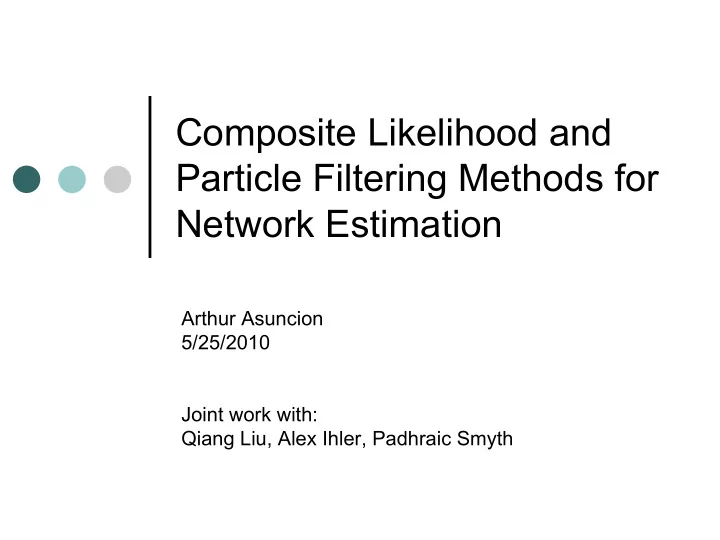

Composite Likelihood and Particle Filtering Methods for Network Estimation Arthur Asuncion 5/25/2010 Joint work with: Qiang Liu, Alex Ihler, Padhraic Smyth
Roadmap Exponential random graph models (ERGMs) Previous approximate inference techniques: MCMC maximum likelihood estimation (MCMC-MLE) Maximum pseudolikelihood estimation (MPLE) Contrastive divergence (CD) Our new techniques: Composite likelihoods and blocked contrastive divergence Particle-filtered MCMC-MLE
Why approximate inference? Online social networks can have hundreds of millions of users: Even moderately-sized networks can be difficult to model e.g. email networks for a corporation with thousands of employees Models themselves are becoming more complex Curved ERGMs, hierarchical ERGMs Dynamic social network models
Exponential Random Graph Models Exponential Random Graph Model (ERGM): Parameters to learn Network statistics (e.g. # edges, triangles, etc.) Partition function (intractable to compute) A particular graph configuration Task: Estimate the set of parameters θ under which the observed network, Y, is most likely. Our goal: Perform this parameter estimation in a computationally efficient and scalable manner.
A Spectrum of Techniques ?? MCMC-MLE MPLE Accurate Inaccurate Composite Likelihood, but Slow but Fast Contrastive Divergence Also see Ruth Hummel’s work on partial stepping for ERGMs: http://www.ics.uci.edu/~duboisc/muri/spring2009/Ruth.pdf
MCMC-MLE [Geyer, 1991] Maximum likelihood estimation: MLE has nice properties: asymptotically unbiased, efficient Problem: Evaluating the partition function. Solution: Markov Chain Monte Carlo. // Equation to transform partition function // Markov Chain Monte Carlo approximation: y s ~ p(y | θ 0 )
Gibbs sampling for ERGMs Since Change statistics then Use this conditional probability to perform Gibbs sampling scans until the chain converges.
MPLE [Besag, 1974] Maximum pseudolikelihood estimation: Computationally efficient (for ERGMs, reduces to logistic regression) Can be inaccurate
Composite Likelihoods (CL) [Lindsay, 1988] Composite Likelihood (generalization of PL): Only restriction: A c ∩ B c is null Consider 3 variables Y 1 , Y 2 , Y 3 . Here are some possible CL’s: MCLE: Optimize CL with respect to θ
Contrastive Divergence (CD) [Hinton, 2002] A popular machine learning technique, used to learn deep belief networks and other models (Approximately) optimizes the difference between two KL divergences through gradient descent. CD- ∞ = MLE CD-n = A technique between MLE and MPLE CD-1 = MPLE BCD = MCLE (also between MLE and MPLE) CD-n, BCD MCMC-MLE, CD- ∞ MPLE, CD-1 Accurate but Slow Inaccurate but Fast
Contrastive Divergence (CD- ∞ ) -- CD- ∞ MCMC is run for an “infinite” # of steps Monte Carlo approximation: y s ~ p(y | θ )
Contrastive Divergence (CD-n) Run MCMC chains for n steps only (e.g. n=10): Intuition: We don’t need to fully burn in the chain to get a good rough estimate of the gradient. Initialize the chains from the data distribution to stay close to the true modes.
Contrastive Divergence (CD-1) and connection to MPLE [Hyvärinen, 2006] Use definition of conditional probability Z( θ ) will cancel Monte Carlo approximation: 1. Sample y from data distribution 2. Pick an index j at random 3. Sample y j from p(y j | y ¬j , θ ) This is random-scan Gibbs sampling. CD-1 with random scan Gibbs sampling is stochastically performing MPLE!
Blocked Contrastive Divergence (BCD) and connections to MCLE Derivation is very similar to previous slide (simply change j → c, y j → y Ac ): We focus on “conditional” composite likelihoods Monte Carlo approximation: 1. Sample y from data distribution 2. Pick an index c at random 3. Sample y Ac from p(y Ac | y ¬Ac , θ ) CD with random-scan blocked Gibbs sampling corresponds to MCLE!
CD vs. MCMC-MLE Sample many y s from θ 0 and Quickly sample y s from θ 0 θ 0 θ 0 make sure chains are burned-in. (don’t worry about burn-in!) y s Calculate gradient based θ 1 on samples and data y s y s Find maximizer of log-likelihood, … using the samples and the data θ 1 Repeat for many θ T Can repeat this procedure iterations a few times if desired
Some CD tricks Persistent CD [Younes, 2000; Tieleman & Hinton, 2008] Use samples at the ends of the chains at the previous iteration to initialize the chains at the next CD iteration. Herding [Welling, 2009]. Instead of performing Gibbs sampling, perform iterated conditional modes (ICM). Persistent CD with tempered transitions (“parallel tempering”) [Desjardins, Courville, Bengio, Vincent, Delalleau, 2009]. Run persistent chains at different temperatures and allow them to communicate (to improve mixing)
Blocked CD (BCD) on ERGMs Lazega subset (36 nodes; 630 edges) Triad model: edges + 2-stars + triangles “Ground truth” parameters were obtained by running MCMC-MLE using statnet.
Particle Filtered MCMC-MLE MCMC-MLE uses importance sampling to estimate the log- likelihood gradient: Data Sample from P(y| θ 0 ) Importance weight: P(y 0 | θ ) / P(y 0 | θ 0 ) Main Idea: Replace importance sampling with sequential importance resampling (SIR), also known as particle filtering
MCMC-MLE vs. PF-MCMC-MLE Obtain samples from θ 0 PF-MCMC-MLE: • calculate ESS to monitor “health” of particles. • resample and rejuvenate particles to prevent weight degeneracy.
Some ERGM experiments Particle filtered MCMC-MLE is faster than MCMC-MLE and persistent CD, without sacrificing accuracy. Synthetic data used (randomly generated). Network statistics: # edges, # 2-stars, # triangles.
Conclusions A unified picture of these estimation techniques exists: MLE, MCLE, MPLE CD- ∞ , BCD, CD-1 MCMC-MLE, PF-MCMC-MLE, PCD Some algorithms are more efficient/accurate than others: Composite likelihoods allow for a principled tradeoff. Particle filtering can be used to improve MCMC-MLE. These methods can be applied to network models (ERGMs) and more generally to exponential family models.
References "Learning with Blocks: Composite Likelihood and Contrastive Divergence." Asuncion, Liu, Ihler, Smyth. AI & Statistics, 2010. "Particle Filtered MCMC-MLE with Connections to Contrastive Divergence." Asuncion, Liu, Ihler, Smyth. Intl Conference on Machine Learning, 2010.
Recommend
More recommend